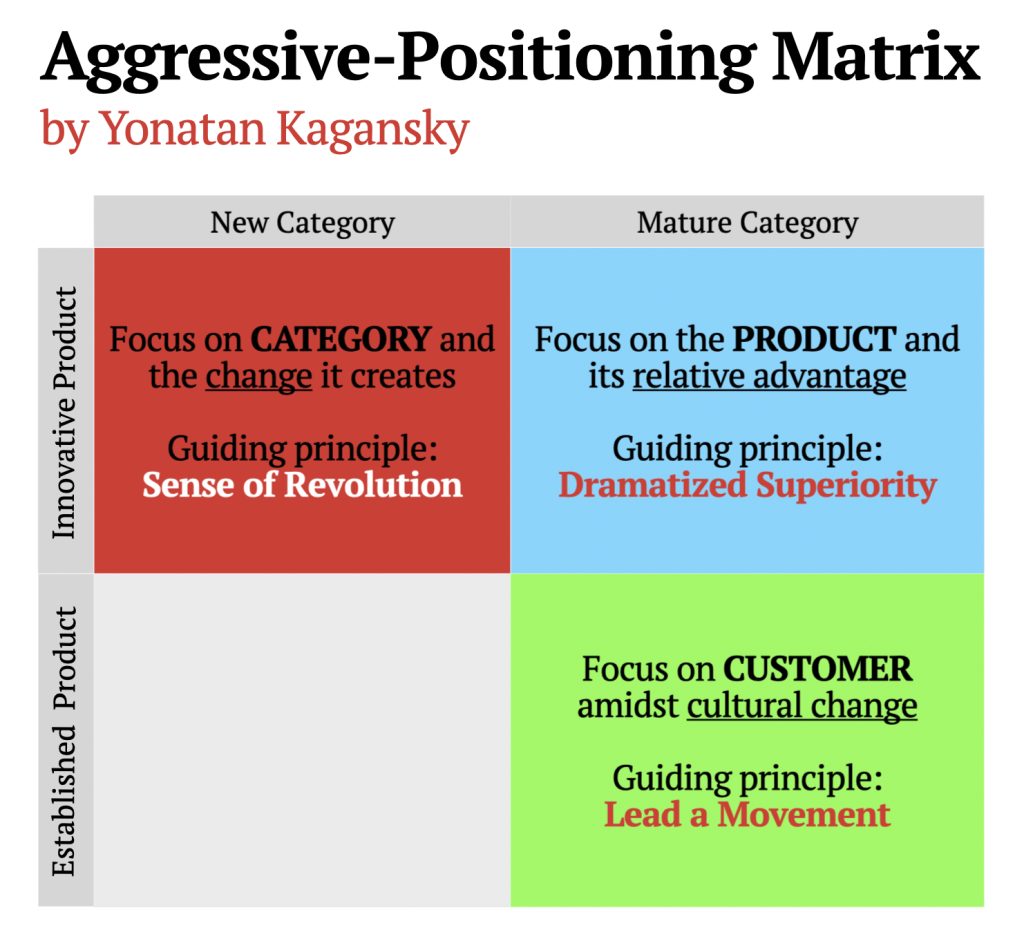We live in an era of constant noise. Ads and marketing proposals yell at us from all fronts. Look at me! Choose me!
At this age, the riskiest thing a brand can do is to be on the safe side. Especially if it’s a small, challenger brand.
Big companies losing market share are exposed to a similar risk.
For them, the safest choice is to start adopting aggressive positioning strategies.
Aggressive-Positioning Matrix

I. New Category: Sense of Revolution
People are creatures of habit. This is why the main challenge when launching a new product in a new category is to shake them off from something they are accustomed to.
It’s not enough to present a new product, you need to create drama. People need to feel that something big is happening.
It’s not enough to say “revolution”, you need to make them FEEL THE REVOLUTION.
B2C Example
This is exactly what Apple did launching the first computer with a GUI – Macintosh. In what is considered the advertising campaign of the 20th century, they created a sense of drama and revolution that established a new category of personal computers and turned Apple into a household brand.
B2B Example
In 2000, 1-year-old Salesforce launched a huge marketing stunt. It intended to promote the new category of cloud computing.
The tiny company targeted the huge Siebel Systems with fake protests demanding to put an end to the traditional software.
The drama of these protests received huge coverage and turned Salesforce into the giant it is today.
Word of caution
You cannot whisper revolution. This is why this strategy demands more resources than usual. It’s go big or go home!
And when you invest a lot and drive a lot of attention to yourself, this attention can backfire.
This is exactly how the New Coke launch failed Coca-Cola in 1985.
II. Mature Category Innovative Product: Dramatized Superiority
Whether it’s a new category or a mature one, when launching a new product you need drama!
The difference here is the focus on one major product advantage (there can be a secondary advantage, but not more than this). Even if the advantage doesn’t seem dramatic, you must blow it up to create a sense of true superiority.
B2C Example
For decades Gillette maintained control over the shaving category by creating a big fuss over every product change.
In 2006 they famously made a lot of drama around the launch of Gillette Fusion with 5 blades, while their competitors already offered 4 blades made of better materials.
B2B Example
The 2013 launch of Volvo Trucks with Dynamic Steering created a lot of noise all over the internet. The buzz was achieved by casting the 90th action star Jean-Claude Van Damme to perform a dangerous split between two moving trucks.
Word of caution
Though in many cases there’s much more hype than actual innovation, your target audience needs to believe you actually offer a superior product.
Gillette, for example, was armed with academic research to prove the superiority of its product.
If you have a good reason to believe your audience won’t buy the hype – consider the third and last aggressive-positioning alternative.
III. Mature Category Established Product: Lead a Movement
Though it’s always great to market products with clear superiority, in most cases, marketers are required to sell products that don’t offer any significant advantages.
In this case, I recommend moving away from the product and product-related customer needs, to more indirect motivations.
This positioning strategy, executed to perfection, has helped many brands achieve dramatic growth without significant product innovation.
B2C Example
Dove Real Beauty Campaign is a perfect example of leading a culturally important movement.
Dove understood the unfair standards the beauty industry creates for women. The choice to lead a movement against these standards is paying off for the company to this day – 20 years later.
B2B Example
While Covid did boost Zoom calls, it wasn’t a new product. Nor was its mobile app. The app did have some product advantages, but Zoom decided to stay away from them in the launch campaign and to bet on a movement against the use of corporate jargon. They hired the comedians Tripp and Tyler for the task and the video went viral.
Word of caution
Choosing the right movement to lead is tricky. It’s very easy to choose an irrelevant direction that will fail a company. How far from a product is too far? How significant is one direction over another? One needs a lot of cultural know-how and sensitivity to walk this thin line properly.
And once you choose a direction, you need to stick with it long enough for it to catch up. Sometimes it can take up to a year for the fruits of this labor to provide higher value than the expanses. But when you’ll see them you will understand it was worth it.
Another thing to keep in mind is that product innovation shouldn’t be neglected completely and some innovation, like new product designs, should accompany any brand. Always.
Need help developing aggressive positioning? Let’s talk.

